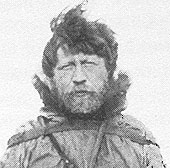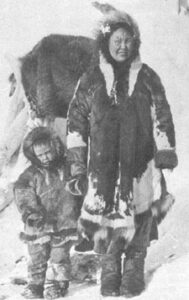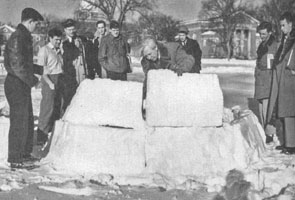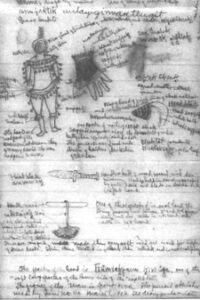 Vilhjalmur Stefansson (November 3, 1879-August 26, 1962), an anthropologist, explorer, book collector, and writer, was an authority on polar regions. At one time a student for the Unitarian ministry, he spent his life as an evangelist for the North. His message was that the Arctic was not a peripheral frozen wasteland populated by savages, but the center of the earth—the “Polar Mediterranean,” he called it—where America, Europe, and Asia come together. He challenged the stereotype of the “Eskimo” as a primitive, inferior race, holding them up instead as models of successful adaptation and teachers from whom we have much to learn.
Vilhjalmur Stefansson (November 3, 1879-August 26, 1962), an anthropologist, explorer, book collector, and writer, was an authority on polar regions. At one time a student for the Unitarian ministry, he spent his life as an evangelist for the North. His message was that the Arctic was not a peripheral frozen wasteland populated by savages, but the center of the earth—the “Polar Mediterranean,” he called it—where America, Europe, and Asia come together. He challenged the stereotype of the “Eskimo” as a primitive, inferior race, holding them up instead as models of successful adaptation and teachers from whom we have much to learn.
Vilhjalmur was born in the Icelandic Canadian settlement of Arnes on the western shore of Lake Winnipeg. Now part of Manitoba, the region was then a self-governing ethnic territory known as “New Iceland.” Vilhjalmur’s parents, Jóhann Stefánsson and Ingibjörg Jóhannesdottir, and his four older siblings had been among 250 immigrants from Iceland who settled there in 1876. Vilhjalmur, the first of the family to be born in the New World, was christened William Stephenson, though his Icelandic-speaking family always called him Vilhjalmur or Villi. He formally adopted the Icelandic form of his name when he was 20 years old.
The year after Villi’s birth, New Iceland suffered flooding, famine and disease. Two of the Stefansson children died. The family moved to the United States, where another Icelandic community had been established in Pembina County, Dakota Territory (now North Dakota). Villi learned English at school, which he attended a few months each year. He received most of his education from his father, who introduced him to the classics of Icelandic and world literature, as well as to liberal thinking in religion and politics. Jóhann Stefánsson was a “modernist” Lutheran who believed that church should incorporate new knowledge, such as the theory of evolution. Recalling religious discussions overheard in childhood, Vilhjalmur later wrote that among the first English phrases he learned were “liberalism in religion” and “higher criticism.”
After his father’s death in 1892, Vilhjalmur went to live on the farm of his older sister and brother-in-law. In his late teens he worked, first with his older brother and then on his own, as a herder of cattle and horses. During this period he developed skills at hunting, outdoor living, and survival in a cold climate.
By 1898 Stefansson had saved enough money to enroll in the preparatory department of the University of North Dakota, Grand Forks. Eager to engage in discussion of the intellectual issues of the day, he found the curriculum and teaching methods disappointingly old-fashioned. Nor was he welcome in the conservative Icelandic community in Grand Forks: he was dismissed from his boardinghouse and fired from his part-time job for speaking admiringly of Darwin and repeating his father’s criticism of Missouri Synod Lutherans. Though happier in the University proper, he continued to express his impatience with the school by challenging the authority of the faculty. In 1902 he was expelled for displaying “a spirit of insubordination and defiance.” For the rest of the school year, he worked as a reporter for the Grand Forks Democratic newspaper, the Plaindealer. As a protest against the University authorities, he ran for State Superintendent of Public Instruction. The following year, he enrolled in the University of Iowa, graduating in 1903.
Stefansson’s first contact with Unitarianism came in 1900, while he was a student at the University of North Dakota. Many Icelandic immigrants to Canada and the United States were liberal Lutherans and some had begun to call themselves Unitarian. At turn of the century the Icelandic Unitarians were beginning to organize and the American Unitarian Association (AUA) was developing its Icelandic Mission. The Icelandic Unitarians, seeking promising young men to study for the ministry, spotted Stefansson. In 1900 the Winnipeg Unitarian church sponsored him to represent them at the International Conference of Liberal Religions in Boston. While there, he met with Unitarian leaders such as William Wallace Fenn and Samuel Atkins Eliot. As a result, he was offered a scholarship to study for the Unitarian ministry at the Harvard Divinity School. He accepted the scholarship on the understanding that he would study religion “as a branch of anthropology.” He would consider ministry but not be committed to it.
Stefansson studied at the Divinity School for one year, 1903-04. Almost six decades later he wrote, “It now seems to me that my Divinity year had greater effect upon the future direction of my career than any time spent at North Dakota or Iowa, or at the Harvard Graduate School.” He particularly remembered professors William Wallace Fenn, who encouraged him to become a minister, and Ephraim Emerton, from whom he learned to reconcile religion with science. Most of all, he was influenced by Samuel McChord Crothers, of First Parish in Cambridge, who advocated “unlearning,” or adopting a skeptical attitude toward received knowledge.
In 1904 Stefansson transferred from the Divinity School to the Peabody Museum, as a graduate student in anthropology. “The idea of reforming Christianity from within . . . appealed to me strongly as an argument for joining the Unitarian ministry,” he wrote, “but in the end I decided in favor of anthropology, with the mental reservation that it was to be a humanistic anthropology.”
Stefansson spent the summers of 1904 and 1905 in Iceland as a physical anthropologist, studying the effect of diet on tooth decay—the beginning of a lifelong interest in nutrition and health. In 1906 Harvard recommended him as anthropologist to the Anglo-American Polar Expedition. When the explorers failed to make their rendezvous with him on the Arctic coast, he used the trip as a training mission. He sought out mentors among the Inuit, studied the language, and honed his cold-weather survival skills. He determined to organize his own expedition, focusing on anthropology. His plan was to immerse himself in Inuit culture, taking no supplies, but living off the land as the Inuit did.
Stefansson returned to New York in 1907 and settled in Greenwich Village, which would be his home, when not in the Arctic, for over 40 years. He arranged for the American Museum of Natural History to sponsor him on a joint expedition with his University of Iowa classmate, zoologist Rudolph Anderson. The “total immersion” method, which required them to devote most of their time and energy to day-to-day survival, was more conducive to anthropological than to zoological research. At times they were reduced to eating 4-year-old whale tongue, tea leaves, ptarmigan feathers, snowshoe lashings, and the natural history specimens they had collected. Stefansson and Anderson remained in the Arctic for four years, 1908-1912. Stefansson gave his account in My Life With the Eskimo, 1913.
 During this expedition, Stefansson—despite the fact that he was engaged at the time to a young woman he had met as a student in Boston—entered into an intimate relationship with an Inuit woman, Fannie Pannigabluk. Though Stefansson’s journals reveal that “Pan,” as he called her, was crucial to the success of his anthropological research as well as to his physical survival, he scarcely mentioned her in his published writings. Their son, Alex Stefansson, was born in 1910. The status of Stefansson’s Inuit family has always been ambiguous. He never acknowledged Alex as his son, though he provided financially for him. Stefansson’s Inuit descendants consider the couple to have been married, pointing out that Stefansson did not marry again until after Pan died in 1940. The Anglican missionary who baptized Pan and Alex in 1915 recorded them as Stefansson’s wife and child.
During this expedition, Stefansson—despite the fact that he was engaged at the time to a young woman he had met as a student in Boston—entered into an intimate relationship with an Inuit woman, Fannie Pannigabluk. Though Stefansson’s journals reveal that “Pan,” as he called her, was crucial to the success of his anthropological research as well as to his physical survival, he scarcely mentioned her in his published writings. Their son, Alex Stefansson, was born in 1910. The status of Stefansson’s Inuit family has always been ambiguous. He never acknowledged Alex as his son, though he provided financially for him. Stefansson’s Inuit descendants consider the couple to have been married, pointing out that Stefansson did not marry again until after Pan died in 1940. The Anglican missionary who baptized Pan and Alex in 1915 recorded them as Stefansson’s wife and child.
Stefansson and Anderson returned to the Arctic as co-leaders of the Canadian Arctic Expedition, 1913-1918. A much more complex venture than they had undertaken before, involving 15 scientists, three ships and their crews, it was plagued from the first by dissention and questions about Stefansson’s leadership and judgment. In 1914 one of the expedition’s ships, the Karluk, sank, causing 11 deaths and great hardships for the survivors—though not for Stefansson, who had been away on a hunting trip when the ship was lost. Stefansson and Anderson quarreled, and became bitter enemies. Stefansson and a few companions went off on to explore their own, traveling more than 20,000 miles over the sea ice. They discovered four uncharted islands and, traveling by dogsled over the ice and drilling holes to take soundings, mapped the mountains and valleys on the floor of the Beaufort Sea.
In 1915 Stefansson was reunited with Pan and Alex. The family remained together for the rest of the trip. Stefansson developed a close relationship with his son during this time. He taught him to speak, read and write English, and considered taking Alex with him when the left the Arctic. He drew on his memories of Alex for a series of children’s books which he co-wrote in the 1920s, notably Kak, the Copper Eskimo, 1924, about the relationship between an Inuit boy and an explorer.
After a serious illness in 1918, Stefansson left the Arctic, never to return. During the 1920s and 30s, as self-appointed “ambassador of the North,” he lectured about the importance of the Arctic and wrote his most influential books, The Friendly Arctic, 1921, and The Northward Course of Empire, 1922. His message was somewhat paradoxical. On one hand, concerned about native peoples being “crushed by civilization’s juggernaut,” he championed traditional, even archaic Inuit ways, arguing that the spread of “modern” ways unsuited to the environment merely led to “pauperication.” On the other hand, he urged governments and businesses to exploit the economic and strategic potential of the Arctic. He saw the Arctic as the crossroads of the world, “a hub from which the other oceans and continents of the world radiate like the spokes of a wheel.” His contention that the Arctic was a “friendly” environment, which posed no threat to anyone who approached it intelligently, was deeply offensive to the survivors of the Canadian Arctic Expedition.
Having resumed his Canadian citizenship in 1913, Stefansson tried during the early 1920s to interest the Canadian people and government in their northern resources. In 1919-20 he served on a Parliamentary commission on northern development and traveled to England to promote further exploration to establish sovereignty over the Arctic islands. When the government was slow to put his ideas into practice, he acted on his own, with disastrous results. A scheme to raise musk oxen for wool came to nothing; a venture to raise reindeer on Baffin Island ended in bankruptcy; and a private expedition to colonize Wrangel Island, off the coast of Siberia, resulted in several deaths and an international incident involving the United States, the United Kingdom, and the Soviet Union. The resulting negative publicity made him for many years persona non grata in Canada.
Stefansson turned in the late 1920s to what he called “a new life as an explorer of human error.” Drawing on his training in “unlearning” at Harvard Divinity School, he wrote two books—Standardization of Error; 1927; Adventures in Error, 1936—in which he wryly cataloged examples of the human tendency to alter facts to accord with preconceived ideas.
For example, Stefansson thought that nutritionists were in error in promoting balanced diet. His experience and research had convinced him of the benefits of a fat meat diet. In 1927-28, under medical supervision, he and a companion from one of his Arctic trips lived for a year on nothing but meat and water. In 1955 he adopted a “stone-age” diet—high-fat, low-carbohydrate, mostly meat—which he credited with helping him maintain fitness and health. He wrote two books on his nutritional theories: Not By Bread Alone, 1946, and Cancer: Disease of Civilization?, 1960.
On lecture tours in the 1920s, Stefansson had begun to collect books and manuscripts about the polar regions. By 1930 the collection contained 10,000 items and had grown from a hobby to “a semipublic institution.” He rented a second apartment to house the collection and hired librarians to catalog it and to answer research questions. From this time on, his primary role would be to administer the library and serve as consultant on Arctic matters. During the 1930s he advised on airline service between the United States and Europe via the “great circle” route using airports in Labrador, Greenland, and Iceland. Beginning in 1935 the United States government commissioned Stefansson and his staff to prepare a bibliography of information about the Arctic, an Arctic survival manual for the Army, and reports on conditions in Alaska for the Air Force. He was re-naturalized as an American citizen around this time.
In 1939 Stefansson helped Evelyn Schwartz Baird, a singer, actor, sculptor, and photographer, get a job preparing exhibits for Icelandic pavilion at the New York World’s Fair, then hired her as a researcher and librarian. Although she had little formal education, she eventually became a polar expert in her own right, and wrote three books on the subject. She and Stefansson were married in 1941. He was 61 years old, she was 28. Despite the age difference, the marriage was a happy one.
During World War II, Stefansson set up an Arctic study center for the U.S. military, consulted on the Alaska Highway and the supply of Canadian oil to Alaska, surveyed weather stations in Quebec and Labrador, wrote a book on Arctic navigation, trained personnel for winter and mountain conditions, and went on a fact-finding tour of Air Force operation in the Aleutian Islands. After the war, he was commissioned by the Office of Naval Research to prepare a 20-volume “Encyclopedia Arctica.” In 1949, with the project incomplete, the Navy canceled the contract, forcing him to lay off most of his staff. No explanation was given, but Stefansson believed that, in those Cold War days, the government had become uneasy about funding a project that required cooperation with the Soviet Union, used Russian-language sources, and employed Russian translators.
 In 1951 Stefansson moved his library to Dartmouth College in Hanover, New Hampshire. The following year a Dartmouth alumnus purchased the Stefansson Collection for the college. The Stefanssons settled in Hanover and became part of the Dartmouth community. Evelyn was employed as librarian of the Stefansson Collection. Stefansson, already over 70, acted as an honorary professor emeritus, writing, lecturing, and serving as a mentor for students in the Northern Studies Center.
In 1951 Stefansson moved his library to Dartmouth College in Hanover, New Hampshire. The following year a Dartmouth alumnus purchased the Stefansson Collection for the college. The Stefanssons settled in Hanover and became part of the Dartmouth community. Evelyn was employed as librarian of the Stefansson Collection. Stefansson, already over 70, acted as an honorary professor emeritus, writing, lecturing, and serving as a mentor for students in the Northern Studies Center.
Shortly after arriving in New Hampshire, the Stefanssons were questioned by the state’s attorney general about their Communist sympathies. In his autobiography, Stefansson presented the investigation as frivolous. In fact, Stefansson had long been sympathetic to Communism and the Soviet Union. He had been attracted to the ideal of communal ownership at least since his days among the Inuit, if not since Harvard Divinity School, where, he said, “they considered Jesus a Communist.” During his early years in New York he had associated with radicals such as Emma Goldman and John Reed. As a champion of Northern development, he admired the Soviet Union’s use of its Arctic resources. He belonged to numerous pro-Soviet organizations, especially during World War II, and, in his enthusiasm for the north, served on an American committee promoting the establishment of a Jewish socialist republic in the far east of Siberia. Fortunately for him, the state investigation did not turn up any of this material.
Stefansson suffered a minor stroke in 1952 and more serious one in 1958. After his second stroke Evelyn took over his teaching duties, though he continued to advise students. During his last years he wrote an autobiography, Discovery, 1964, which concludes with reflections on religion. He credited his year at the Harvard Divinity School with giving him the tools he needed to make sense of Inuit religion and with showing him that he could outgrow his childish ideas of God without becoming an atheist. In adult life he considered himself an agnostic: “I prefer to think that agnosticism is the only modest faith.” Though not a regular churchgoer after his student days at Harvard, he remained attached to the AUA. He corresponded with Frederick May Eliot, served on the continental board of directors of the Unitarian Laymen’s League, and in 1956 was treated as an honored guest at AUA headquarters.
Shortly after completing his autobiography, Stefansson died of a stroke. For a time he was remembered merely as a last remnant of the heroic age of polar exploration. In recent years he has been honored as a pioneer of the interdisciplinary, international approach to the study of polar regions. The Institute of Arctic Studies, established at Dartmouth College in 1989, takes as its motto a quotation from The Northward Course of Empire: “There is no northern boundary beyond which productive enterprise cannot go until North meets North on the opposite shore of the Arctic Ocean.” The Institute offers a Stefansson Fellowship to support field work in Arctic. In 1998 the Stefansson Arctic Institute was established in Akureyri, Iceland. There has also been renewed attention to his anthropological work, particularly on Inuit religion. He is considered a pioneer of the “participant-observer” method of anthropological fieldwork.
 Stefansson’s papers and diaries, together with the library of information on the Arctic which he amassed, are in the Stefansson Collection, Dartmouth College, Hanover, New Hampshire. Some letters relating to Stefansson’s relations with the American Unitarian Association are in the Unitarian Universalist special collection at Andover Harvard Theological Library in Cambridge, Massachusetts. Selections from his ethnographic notebooks were published in Gisli Palsson, ed., Writing on Ice: The Ethnographic Notebooks of Vilhjalmur Stefansson (2001). He recorded the Stefansson-Anderson Arctic Expedition in Anthropological Papers of the American Museum of Natural History (1914). Writings of Stefansson, not mentioned above, include Hunters of the Great North (1922), The Adventure of Wrangel Island (1925), The Three Voyages of Martin Frobisher (1938), Iceland: The First American Republic (1939), Unsolved Mysteries of the Arctic (1939), Ultima Thule (1940), Greenland (1942), Arctic Manual (1944), Compass of the World (with Hans W. Weigert, 1944), Great Adventures and Explorations (with Olive Rathbun Wilcox, 1947), and Northwest to Fortune (1958). His main collaborator in the children’s books was Violet Irwin. Besides Kak, the Copper Eskimo, they wrote The Shaman’s Revenge (1925) and The Mountain of Jade (1926). With Julia Schwartz he wrote Northward Ho! (1925). In addition Stefansson wrote many magazine articles and reviews. There is a complete bibliography in William R. Hunt, Stef: A Biography of Vilhjalmur Stefansson, Canadian Arctic Explorer (1986).
Stefansson’s papers and diaries, together with the library of information on the Arctic which he amassed, are in the Stefansson Collection, Dartmouth College, Hanover, New Hampshire. Some letters relating to Stefansson’s relations with the American Unitarian Association are in the Unitarian Universalist special collection at Andover Harvard Theological Library in Cambridge, Massachusetts. Selections from his ethnographic notebooks were published in Gisli Palsson, ed., Writing on Ice: The Ethnographic Notebooks of Vilhjalmur Stefansson (2001). He recorded the Stefansson-Anderson Arctic Expedition in Anthropological Papers of the American Museum of Natural History (1914). Writings of Stefansson, not mentioned above, include Hunters of the Great North (1922), The Adventure of Wrangel Island (1925), The Three Voyages of Martin Frobisher (1938), Iceland: The First American Republic (1939), Unsolved Mysteries of the Arctic (1939), Ultima Thule (1940), Greenland (1942), Arctic Manual (1944), Compass of the World (with Hans W. Weigert, 1944), Great Adventures and Explorations (with Olive Rathbun Wilcox, 1947), and Northwest to Fortune (1958). His main collaborator in the children’s books was Violet Irwin. Besides Kak, the Copper Eskimo, they wrote The Shaman’s Revenge (1925) and The Mountain of Jade (1926). With Julia Schwartz he wrote Northward Ho! (1925). In addition Stefansson wrote many magazine articles and reviews. There is a complete bibliography in William R. Hunt, Stef: A Biography of Vilhjalmur Stefansson, Canadian Arctic Explorer (1986).
Along with Stefansson’s autobiography, Discovery (1964), there is an autobiography of his second wife: Evelyn Stefansson Nef, Finding My Way: The Autobiography of an Optimist (2002). Besides William R. Hunt’s book, biographies of Stefansson include Donat Marc Le Bourdais, Stefansson: Ambassador of the North (1963); Richard J. Diubaldo, Stefansson and the Canadian Arctic (1978); Gisli Palsson, Travelling Passions: The Hidden Life of Vilhjalmur Stefansson (2003); and a chapter in Pierre Berton, Prisoners of the North: Portraits of Five Arctic Immortals (2004). Information about Stefansson’s Unitarian connections is found at “A Canadian Unitarian Almanac and Liturgical Calendar” (Stefan M. Jonasson, 2002).
Article by Lynn Gordon Hughes
Posted February 12, 2006